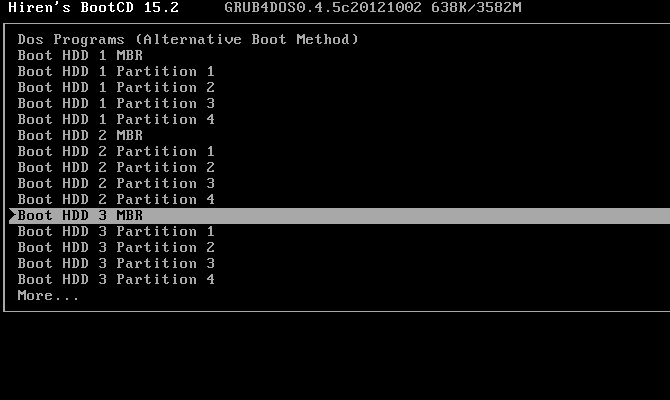Summary :
- Hiren Boot Cd Windows 7
- Hirens Boot Cd 32 Bit Uefi Usb
- Hirens 32 Bit Download
- Hirens Boot Cd 32 Bit Uefi Installer
- Hiren's version 16.3 Boot CD USB Computer Repair Recovery Win 7,8,Vista & XP,10. Condition is Brand New. Shipped with USPS. Hiren’s Boot DISK on USB PE x64 (v1.0.1) V 16.3. We also included a bunch of free bootable bonus tools on the drive. Directions 1: plug usb Into pc 2: reboot pc.
- Updated download link for new Hiren's BootCD PE from 1.0.0 to 1.0.1 BattStat 0.99b: Battery Status monitor and power management freeware for Windows 7/Vista/XP/2000 x86/x64.
Hiren’s boot CD is one of the very few useful toolkits that will help in resolving any type of computer boot issues, scanning malwares, backup and restore PC data, recovering Windows password etc. To create Hirens boot USB you will need following things. Hiren’s boot CD 15.2 ISO. Hiren’s boot CD is one of the very few useful toolkits that will help in resolving any type of computer boot issues, scanning malwares, backup and restore PC data, recovering Windows password etc. To create Hirens boot USB you will need following things. Hiren’s boot CD 15.2 ISO.
What is UEFI boot mode? How to create a UEFI bootable USB? How do I boot from USB in UEFI mode? If you are also troubled by these questions, this post of MiniTool is what you need. It will provide you with detailed steps and clear screenshots.
Quick Navigation :
About UEFI Boot
Why do so many people want to create a UEFI boot USB? In order to create a UEFI bootable USB successfully, it is necessary to figure out the following 2 questions first.
What Is UEFI
UEFI (Unified Extensible Firmware Interface) is known as a motherboard firmware interface for computers. It serves as a “middleman” between your computer’s firmware and the operating system. With UEFI boot mode, your computer can initialize the hardware components and boot the OS stored on the hard disk.
In recent years, UEFI boot mode seems to be the successor to the BIOS. More and more users tend to boot their computer in UEFI mode. This is because the UEFI mode breaks many limitations of BIOS mode, including the restrictions on the size of hard drive, booting process, number of partitions, and security.
In a word, UEFI boasts more advanced features compared with BIOS. Here we summarize them as follows:
- UEFI allows users to handle a storage device that is larger than 2TB, while the old legacy BIOS cannot handle so large d
- With UEFI boot mode, you can create more than 4 primary partitions on a GPT disk.
- UEFI supports secure startup. It is capable of checking the validity of the operating system to prevent malware from tampering the startup process.
- UEFI firmware supports various optimization and enhancement, which can help your system boot more quickly than it could before.
- UEFI supports both 32-bit and 64-bit architectures, which helps the computer use more RAM to handle a more complicated process than BIOS.
- Under the UEFI mode, the computer supports networking function that can help remote troubleshooting and UEFI configuration.
- UEFI has much more setup menus and simpler graphical user interface than legacy BIOS.
What Support UEFI Boot Mode
UEFI has lots of advantages over BIOS, but not all computers and devices are supported. In order to boot from USB in UEFI mode successfully, the hardware on your hard disk must support UEFI. One of the most important things is to make sure that your system disk is GPT form. If not, you have to convert MBR to GPT disk first.

If your hardware doesn’t support the UEFI firmware, you need to purchase a new one that supports and includes UEFI.
Now, you may have an overall understanding of UEFI boot mode. Let’s see how to create a Windows 10 UEFI boot stick. Please keep reading the following part carefully.
How to Create a UEFI Bootable USB
How to create a UEFI boot USB? Before starting the following steps, you need to prepare a USB flash drive with 8GB space at least.
Method 1. Use Windows Media Creation Tool
Windows Media Creation Tool is one of the most common ways to create a bootable USB drive. Similarly, you can use it to create a UEFI boot USB.
Tip: This method is suitable for those computers that are using UEFI firmware. To create a UEFI boot USB, you can perform a clean installation or in-place upgrade of the OS.
Now, let’s see how to create a Windows 10 UEFI USB via Windows Media Creation Tool.
Step 1. Make sure the USB flash drive is connected to your computer.
Step 2. Click here to download the Windows Media Creation Tool from Microsoft's official website and save it on your computer.
Step 3. Run this program as an administrator and click on Accept to agree with the license terms.
Step 4. In the pop-up window, click the second option Create installation media USB flash drive, DVD, or ISO file) for another PC and click on the Next button.
Step 5. Then check the box Use the recommended options for this PC and click on Next to go on, which will automatically select the language, edition, and architecture that match with your computer.
Step 6. Select the USB flash drive option and click on Next to go on.
Step 7. Then select the USB flash drive from the Removable drives list and click on Next to go on. If you don’t find the USB drive, click on the Refresh drive list option.
Step 8. Now, this tool will download the latest Windows 10 installation files that you select above on your device. Once the download is completed, click on Next to start creating the Windows 10 bootable USB.
Step 9. Once you see the screen Your USB flash drive is ready, click on the Finish button.
Now, the Windows 10 UEFI boot stick has been created. You can use it to boot your computer and install Windows 10.
In addition to using the tool of Microsoft, here are another 2 effective utilities that can help you create a UEFI boot USB.

Method 2. Use Rufus
Rufus is an open-source program that can create a UEFI bootable USB by using an existing ISO file. Connect your USB flash drive to the computer and then follow the steps below:
Step 1. Click here to download Rufus and install the program on your PC.
Step 2. Launch this program to open its main interface, and then select the USB flash drive from the Device menu.
Step 3. Click on the Select button under the Boot selection tab, and then select the Windows 10 ISO file from its folder path.
Step 4. Select the Standard Windows installation option from the Image option drop-down menu.
Step 5. Select the GPT option from the Partition scheme drop-down menu.
Step 6. Select the UEFI (non-CSM) option from the Target system drop-down menu
Step 7. Then you can click on Show advanced drive properties section and keep the default settings.
Step 8. Enter a name for the USB drive in the Volume label field, and then you can select a File system and cluster size from the drop-down menu.
Step 9. After the Format Options are confirmed, click on the Start button.
Step 10. Click on the OK button to confirm this process and click the Close button.
After finishing the above steps, this tool will create a UEFI bootable USB drive automatically.
Method 3. Use MiniTool Partition Wizard
MiniTool Partition Wizard is another effective tool that can help you create a UEFI boot stick. It is a reliable partition manager that boasts many powerful features such as resize partition, convert FAT to NTFS without data loss, convert MBR to GPT disk, migrate OS to SSD, etc.
Hiren Boot Cd Windows 7
As mentioned above, the UEFI mode requires a GPT disk. If your USB is the MBR partition table, you need to convert it to GPT first. MiniTool Partition Wizard can help you convert MBR to GPT without data loss. It is very simple to operate. Here’s how:
Step 1. Connect the USB flash drive to your computer and launch this program to get its main interface.
Step 2. Select the USB drive and click on Convert MBR Disk to GPT Disk feature from the left pane.
Step 3. Click on Apply to execute the pending operation.
After your USB flash drive is converted to GPT, you can move your Windows 10 to this drive. To do so, continue the following steps.
Step 1. In the main interface, select the Migrate OS to SSD/HD Wizard feature from the left pane.
Step 2. Select Option B to copy the system required partitions only and click on Next to go on.
Step 3. Select the USB drive and click on Next. Then you will see a warning message saying that all the data on the target disk will be destroyed. Click on Yes to confirm this operation.
Step 4. Select a copy option based on your needs and click on Next to continue.
Step 5. Click on the Finish button. At last, click on Apply to execute the pending operations.
After that, Windows 10 will be migrated to the USB drive. You can set the USB as the first boot order and use it to boot your computer.
Now, another question comes into being. How do I boot from USB in UEFI mode? Please keep reading the following part.
How Do I Boot From USB in UEFI Mode
In this part, we mainly focus on how to boot from USB in UEFI mode. You need to enable the UEFI mode first and then use the UEFI boot USB to start your computer.
Step 1. Power on your computer, and then press the F2 keys or other function keys (F1, F3, F10, or F12) and the ESC or Delete keys to open the Setup utility window.
Step 2. Navigate to the Boot tab by pressing the right arrow key.
Step 3. Select the UEFI/BIOS Boot Mode, and press Enter.
Step 4. In the pop-up window, select the UEFI Boot Mode by pressing the up and down arrow keys, and then press Enter.
Step 5. Press the F10 key and Enter to save the change and exit the window. Here the key depends on your specific computer manufacturer. After that, you can try using the bootable USB to start your computer in UEFI mode.

Wrapping Up

How to create a UEFI bootable USB on Windows 10? Now, I believe that you already have known the answer. Bear in mind that you need to make sure the drive is GPT partition table so that you can use it to boot your computer in UEFI mode successfully.
If you have any questions about this software, you can send us an e-mail via [email protected]. We also appreciate any ideas about this topic in the comment area.
UEFI Boot USB FAQ
To enable the UEFI boot mode, you need to access the BIOS Setup utility and then operate further. Here’s how:
- Press F10 and ESC (or Delete) keys when booting your computer to open the BIOS Setup utility.
- Go to the Boot tab and select the UEFI/BIOS Boot Mode by using the arrow keys, and press Enter.
- Select the UEFI Boot Mode by pressing the up and down arrow keys and press Enter.
- Press F10 keys to save the changes.
Hirens Boot Cd 32 Bit Uefi Usb
Hirens 32 Bit Download
You need to prepare a Windows 10 bootable USB and follow the steps:
Hirens Boot Cd 32 Bit Uefi Installer
- Connect the USB drive to your computer.
- Press the appropriate key to enter the BIOS menu.
- Select the USB drive as the first boot order and save the change.
- Restart your computer.